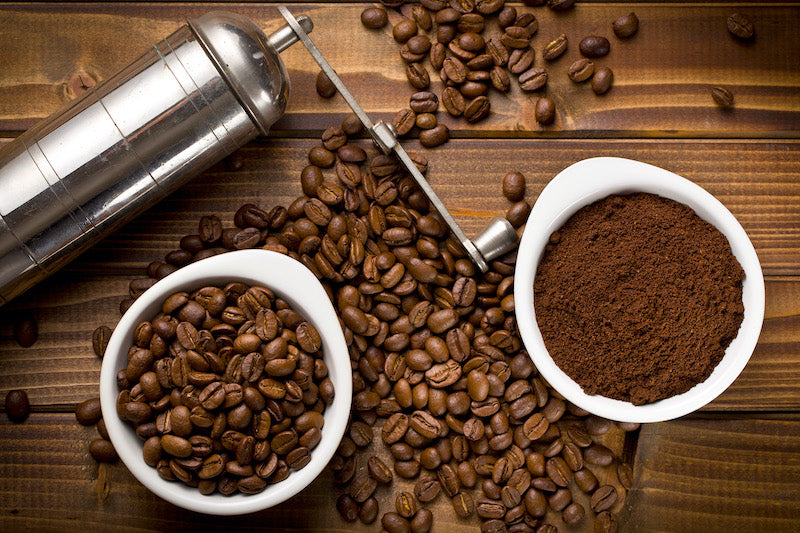Part of the reason people enjoy going out for coffee rather than making instant coffee at home is that instant coffee and ground coffee are completely different. Most people would say that ground coffee is almost a different drink entirely due to its complexity of flavors and higher quality. Instant coffee is great in a pinch and will get you the caffeine you crave, but it just won’t have that same real coffee taste. So, how can you get the great taste of ground coffee at home? Learn the method of grinding coffee beans, which you can even learn to do without a grinder!

Grinding Coffee Beans
While one of the most common ways to coffee grind beans is by using a coffee grinder, not everyone wants to invest in one. There are less expensive models, but often these are manual or only grind a very small amount of coffee at a time. These usually cost about ten dollars, but the price ranges for different varieties. Electric coffee grinders cost about $15 at their cheapest, but costs can increase up to hundreds of dollars. If you want to learn how to grind coffee beans without a grinder, there are several ways to do so. Then, if you enjoy coarse ground coffee, you might make the decision to purchase a grinder.
How to Grind Coffee Beans Without a Grinder
There are several methods you can use to grind coffee beans without a grinder, which may produce a bit more coarse ground coffee, but they work! Coarse ground coffee doesn’t often affect the taste of the coffee, but it can affect the caffeine concentration. A finer grind might result in a more bitter coffee. See what you like best by trying several different procedures:
Blending the Coffee Beans
You can use your blender to coffee grind beans! Depending on the quality of your blender, you can usually get a good grind, but it will likely be more coarse than you might expect. Be careful to grind the beans in short bursts when using this method, as it might actually heat the beans and change their flavor, making results more bitter. The pieces will likely be different sizes as well.
Use a Food Processor
A food processor is similar to a blender, but more likely to provide a finer grind. It also won’t cause the beans to overheat as quickly because they have more space to move around. Use a smaller amount, (about ¼ cup), to get the most consistent grind. With practice, this can produce a pretty uniform grind. You can also try shaking or tipping the processor between grinds when it isn’t running to make sure they all get ground.
Mortar and Pestle
This method takes a little more work for you, but will likely produce a finer grind with a great flavor. Place a small number of beans into your chosen mortar and pestle and grind it until it comes out to your desired size. This is a great way to try the difference in grind sizes, so you can see what tastes the best to you. Try not to place too many beans in the mortar as it might cause the grounds to spill over the sides when you grind the beans.
Other Kitchen Utensils
You can use a knife and cutting board, meat tenderizer, or even a hammer to grind your coffee beans in a pinch. You can crush them with a rolling pin or other utensil as well. You might want to try putting the beans in a plastic bag if you are pulverizing them, so they don’t spread everywhere. Be careful when cutting your beans with a knife. This method will likely take the longest, but you have a great deal of control over the size of the coffee grounds.

Tips for Grinding Coffee Beans Yourself
When you are learning to grind coffee beans, there are a few things you can do that make it easier or the coffee better tasting.
Spritz the Coffee Beans With Water
If you want to reduce friction and static within your coffee grind, take a small spray bottle and spritz the beans with water prior to grinding them. This helps prevent bitter flavors and can often make the grinding easier, often leading to better results. Be careful not to spray too much water on the beans, as this could lead to other issues. You can avoid some of this by shaking around the beans as you spray them with water.
Leftover Grounds
If you are learning how to grind coffee beans and end up with leftover coffee grounds, be sure to store them in an airtight container until you are ready to use them. Try to keep them away from light, moisture, and heat for the best results. Most people place them in a pantry or cabinet. Don’t keep the coffee grounds if they get wet! These cannot be reused and should be thrown away. Bacteria or mold might grow in the container or on the beans themselves, so be safe and throw away any wet grounds. If you lightly spray them to help with grinding, they should still be good to keep. The grounds should be good for about one week after grinding.

Purchasing Good Coffee Beans
Now that you know how to grind coffee beans at home, how do you know which ones are the best? You can try different varieties to see which you like best, and there are so many things you can do to create the cup of coffee you love. An easy way to do this is to stop by and try our different coffee blends to see what you like best before you purchase a bag! The perfect cup of coffee is truly within reach, especially when you use ground coffee rather than instant. Bring your morning to life with high-quality coffee beans, either from the comforts of home or the classic atmosphere of a beautiful coffee shop.

